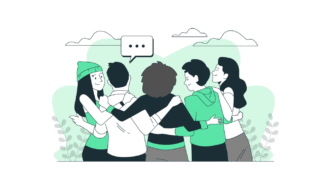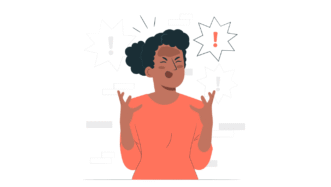LESSON OVERVIEW
The main objectives of this lesson are to:
- practise vocabulary to talk about accents;
- discuss challenges related to accents and pronunciation;
- watch an explainer video on accents in a foreign language.
In this lesson, students talk about how they feel speaking a foreign language, watch a short video showing how speakers of English can struggle to understand different accents and learn vocabulary to discuss the topic (e.g. esteemed, exploit, glamorize, etc.). They talk about pronunciation and accents and watch an explainer video. Students also discuss tips on how to improve pronunciation in a foreign language and do pronunciation activities.
VOCABULARY AND DISCUSSION
This lesson starts with a warm-up where students share their perspectives on understanding and expressing themselves in a foreign language. After that, they watch a short video about someone struggling to understand an accent and discuss challenges in comprehending English and implications for learners’ confidence. Then, students replace words and phrases in sentences with words related to the diversity and perception of accents.
Afterwards, students talk about accents. They look at the statements again, choose one idea they agree with and one idea they disagree with and give their reasons. Following that, they practise the target vocabulary and complete gaps in a text as well as questions about media portrayal of accents. Next, students read the text again and discuss the questions. They also brainstorm ways to promote more accurate and respectful representations of accents and cultures in the media and popular culture.
VIDEO AND PRONUNCIATION
In this part of the lesson, students talk about accents and English pronunciation challenges. Following that, they look at some words ( e.g. Paris, Mbappe, civilization, etc.) and discuss why they might be difficult for someone to pronounce. Next, they watch the first part of the explainer video and say what rule or aspect of pronunciation they exemplify.
Then, students watch the second part of the video and make notes about one more thing that makes English pronunciation different from that of other languages. Finally, they look at tips on how to improve pronunciation in a foreign language and discuss which they have tried, would like to try and wouldn’t try. Additionally, they share what other things they have tried or heard about that help to improve pronunciation. Finally, students do some pronunciation activities in which they examine pronunciation tips and do some tasks. First, they practise the /p/, /t/ and /k/ sounds. Secondly, students work on word stress. Then, they learn about content words and practise sentence stress.
HOMEWORK/REVISION
This lesson also includes an additional task that you can use as homework or revision. In the task, students create sentences about pronunciation and accents. The task is available in the teacher’s version of the worksheet. You can print it and hand it out to your students. It’s also included in the e-lesson plan.
Subscribe to unlock these and many other Standalone lesson with the Premium planWORKSHEETS














Hey Olia! Thank you so much for this lesson!
Regarding accents – just wondering if it may be possible for more classes on this subject? I’m realising that many of my students are struggling with certain accents (namely those who work in tech and deal with Indian accented English for tech support) and regions like Northern English (Yorkshire etc). Perhaps I need more of a deep dive on the net, but I’m finding it difficult to come up with decent material for developing comprehension. It’s hard enough for us natives sometimes 🙂 Thanks again!
Thanks for the feedback! We’ll take it into consideration as we develop new content to support comprehension of different accents. Stay tuned for updates!
Thanks for this pronunciation lesson. You’ve created something really interesting from the various aspects of pronunciation.
Thanks, I’m really glad you liked it 🙂
Lovely lesson! Looking forward to using this tonight with a student.
Great, let us know how it goes!
Thank you for such a useful lesson! I can’t stress enough how important the pronunciation is and how often it is disregarded by the educators.
Thanks for your comment! And we totally agree that teaching pronunciation is important 🙂
Thank you so much! 🙂 I only noticed one mistake here, you’re writing watch a video instead of watch the video before the links
Thank you for your feedback🙂 If you’re referring to slides 4 and 22, we use ‘a’ the first time we mention the video, and in all other instances, we use ‘the’.
That’s not accurate when it comes to this specific instance. Saying “watch a video” indicates that we could watch any video on the internet. But since you have the link right after, “the” is correct because it’s now specific and known to both the speaker and the listener. 🙂
I wanted to comment on the following (Slide 27)
“The speaker mentions that the rhythmic patterns of English, where stressed syllables occur at regular intervals while the others are less distinct, make its pronunciation differ from other languages, like Italian.”
Is this correct? I find it quite confusing. Wouldn’t we say that the rhythmic pattern of English is IRREGULAR, unlike Italian or Spanish, for example, whose rhythmic patterns is regular because every syllable is stressed.
The video explains that in English stressed syllables come at roughly regular intervals, while the others are less distinct. This doesn’t mean the rhythm is completely regular – only that stress patterns follow this general tendency. In contrast, Italian and Spanish are syllable-timed, meaning every syllable has a more even duration, making their rhythm feel more regular. So, while English might seem ‘irregular’ compared to syllable-timed languages, it still follows a stress-timed pattern.
Hi Olia! Great job on the content of this lesson. My student and I truly enjoyed the discussion and the practice. Are there more lessons dedicated to pronunciation on the website? I only found this one!
Hi! Thanks, I’m really glad you and your student enjoyed it! We don’t have many lessons specifically devoted to pronunciation, but we do try to include different activities, like word pronunciation here or tongue twisters here.